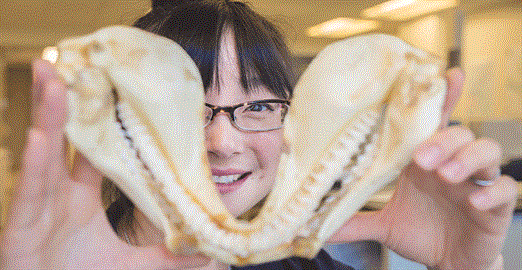
Forty million years after dinosaurs went extinct, one of the largest predators that ever prowled Earth’s oceans emerged, feeding the imaginations of modern scientists and the nightmares of modern movie audiences.
Megalodon — the name means ‘giant tooth’ — appeared some 23 million years ago and reigned the seas for about 21 million years. In 400 million years of shark evolution, megalodon is the most massive shark species that ever lived, growing to 60 feet long, or three times the size of the largest of today’s great whites.
But megalodon went extinct about 2.5 million years ago, and UC Merced paleoecology Professor Sora Kim wants to know why.
Through a three-year project funded by a $204,000 grant from the National Science Foundation , Kim hopes to learn about the megalodon’s diet, habitat and physiology and whether they played a role in the shark’s disappearance. Kim’s team of co-investigators includes paleoclimatologist Michael Griffiths and environmental scientist Martin Becker, both from William Paterson University, paleobiologist Kenshu Shimada from DePaul University and marine scientist Robert Eagle from UCLA.
“There are many ideas about why the megalodon went extinct,” Kim said. “Scientists have argued that changes in the megalodon’s available prey base combined with climate change led to their demise. But these are just hypotheses. There have been no rigorous studies that demonstrate this conclusively.”
What makes the megalodon’s emergence, existence and ultimate extinction a mystery for the researchers is that the anatomy of these ancient sharks was much like that of modern sharks, with skeletons made of cartilage rather than bone. This feature — also common to rays and skates — distinguishes them from other vertebrates. But it means sharks don’t leave behind large fossilized remains like other animals with skeletons composed primarily of bone do. Bone is mineralized and fossilizes; cartilage doesn’t — at least not well.
Luckily for Kim and her colleagues, there’s an exception to the rule: Just like modern sharks, megalodon’s teeth were made of calcium phosphate, so the fossil record is replete with dental remains. Shark teeth are actually the most abundant vertebrate fossil, in part because a single shark sheds thousands of teeth in its lifetime, and the mineralized enameloid — similar to the enamel on mammals’ teeth – is extremely resistant to alteration.
Using fossilized teeth from different sites around the world that span megalodon’s time as the ocean’s apex predator, the researchers will use a suite of analytical methods not typically used in paleontology to probe them and improve understanding of the largest shark that ever swam Earth’s oceans.
“I’ll use stable isotope analysis and build a bridge between classical paleo and modern techniques,” Kim said.

By performing “isotope fingerprinting” on oxygen, strontium, calcium and other trace elements found in fossilized megalodon teeth, Kim and colleagues will be able to answer fundamental questions about megalodon that have eluded scientists up to now.
“What did the meg eat? Could megalodon regulate its own body temperature? What was its environment like? And why did it go extinct? Isotope fingerprinting will provide more definitive answers to these questions,” Kim said.
Kim is part of the Department of Life and Environmental Sciences with the School of Natural Sciences . More than just an accomplished researcher, Kim is also a dedicated educator, and her new NSF grant reflects her interest in bringing science to undergraduates, especially those from groups underrepresented in science.
“We need to bridge the gap between the undergraduate and graduate experience for underrepresented minorities who want to pursue science,” Kim said. “That means providing them with intensive mentoring and an authentic research experience.”
As part of the grant, undergraduates from William Paterson University will have the opportunity to get hands-on research experience at UC Merced and Rutgers, attend scientific conferences and receive direct mentoring from Kim.
“UC Merced can provide a unique research experience for underrepresented minority undergraduates,” Kim said. “These students will come to campus and see students from similar backgrounds engaged in serious research. That can change what they think a research experience is supposed to look like.”

Senior Writer and Public Information Representative
Office: (209) 228-4406
Mobile: (209) 201-6255